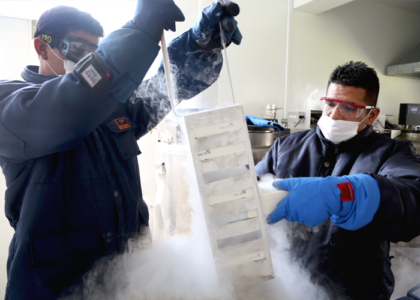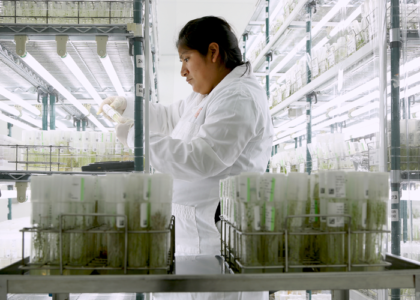
With the world on track for an average temperature increase of more than 1.5 ºC and the population burgeoning toward 10 billion by 2050, farmers need new tools to meet increasing food demand and adapt to climate change. Some of those tools may be hidden in the biodiversity of crops themselves, or their wild relatives, as some species and cultivars have genes that confer tolerance to climatic stress or disease resistance that crop breeders can use to develop more robust, resilient varieties.
This is one of the reasons the International Potato Center (CIP) genebank safeguards more than 4,800 genetically unique potato accessions and 5,500 sweetpotato accessions in trust for humanity, and shares samples of that biodiversity with institutions across the globe for research, crop improvement, or distribution to farmers. To ensure that agrobiodiversity is available for future generations, CIP scientists developed a protocol for storing potato accessions theoretically indefinitely in liquid nitrogen, at -196 °C, an innovation called cryopreservation.
A recently published book chapter documents that protocol to facilitate its wider use and adaptation for other crops. It contains a step-by-step description of a process for cutting and cryopreserving tiny potato shoot tips that was based on one developed for banana and refined through years of experimentation.
“The purpose of the book chapter is to help more organizations use cryopreservation technologies for germplasm conservation. It thus contains details that normally wouldn’t be included in a scientific paper,” says Rainer Vollmer, the chapter’s lead author, who heads cryopreservation at the CIP genebank.
CIP began experimenting with cryopreservation in the late 1990s, and has since created the world’s largest potato cryobank, with shoot tips of more than 3,800 accessions – about 78% of the genebank’s collection of cultivated potato diversity – currently conserved in deep freeze.
Genebank technicians periodically remove and warm a shoot tip and see if it grows into a healthy plant, to ensure the process is working. Frozen samples were once shipped from Lima to the Alliance of Bioversity and CIAT genebank in Belgium, stored there for about a month, then shipped back to Peru, where they were thawed and grown. However, each potato variety is different, not all have been successfully cryopreserved; the average recovery rate is currently 60%.
Sweetpotato has proven to be a much more difficult crop to cryopreserve, and only five percent of the genebank’s vast sweetpotato collection is currently in the cryobank. Vollmer, however, is confident that his team will develop an effective protocol for that crop.
“We’ve learned a lot from our success with potato and are using it to adapt the protocol to sweetpotato,” he says.
Conservation challenges
Crop biodiversity is threatened globally by climate change, urbanization, crop diseases and farmers’ substitution of traditional varieties with commercial, which makes genebank collections increasingly important. Most genebanks safeguard seeds, but potato and sweetpotato are “clonal” crops, for which farmers plant tubers or vines, and each generation is genetically identical to the mother plants. CIP thus conserves their biodiversity in vitro – as small, disease-free plants in test tubes – rather than seeds. Those plantlets are stored in refrigerated chambers to reduce their growth rate, so they can be moved to a greenhouse and quickly grown to produce planting material or plants for breeding. However, potato plantlets need to be regenerated every one to three years, when tissue cuttings are taken to produce new plantlets, which are then stored in vitro for another one to three years.

That renovation is relatively labor-intensive and expensive, and there is a risk of accessions becoming mixed up, getting contaminated with pathogens, or suffering changes in their genetic material provoked by the process. Cryopreservation eliminates the need for this regeneration and is more cost- and space-efficient in the long run. And the long run is what cryopreservation is all about since it theoretically enables conservation in perpetuity. The process of preparing and freezing a potato shoot tip is challenging, since the formation of ice crystals must be avoided, as they that can damage the plant’s cells. However, once the material is frozen, the cost of conserving it minimal.
“It’s like solar panels. They’re a big investment in the beginning, but over time, they save you money,” observes Vania Azevedo, the head of the CIP genebank and Biodiversity for the Future Program. She noted that because cryopreservation requires little space, it could facilitate conserving duplicates of collections to reduce the risk of biodiversity loss in a natural disaster. “We want to guarantee that the genetic resources we safeguard are backed up in the most cost efficient way possible,” she says.
The genebank’s in vitro collections are currently backed up at CIP’s research station in Huancayo, Peru, the Brazilian Agricultural Research Corporation (EMBRAPA) in Brasilia, Brazil, and the Alliance of CIAT and Bioversity genebank in Cali, Colombia, whereas its seed collection is backed up in the Svalbard Global Seed Vault, on an Arctic island in Norway.
Azevedo says she expects more organizations to adopt cryopreservation, noting that it could be promoted under the Global Potato Conservation Strategy, coordinated by the Global Crop Diversity Trust, which thus far involves 32 potato genebank collections in Asia, Europe and the Americas. Globally, 89 national institutions and two international genebanks safeguard potato biodiversity, with a total of 79,850 accessions, so there is ample opportunity for cryopreservation to be used.
Azevedo adds that the potato protocol may also contribute to the use of cryopreservation for conserving other clonal crops, such as cassava or yam, or crops whose seeds are extremely difficult to preserve.
“We already know that cryopreservation is the future for clonal crops, and crops with recalcitrant seeds, but there is still a lot of research that needs to be done,” Azevedo explains. “We always need model crops that protocols can be developed for and then adapted, and I think that potato could be one such a model crop. That means that this book chapter could have a broad impact on biodiversity conservation.”
CIP’s cryopreservation efforts have been supported by the Global Crop Diversity Trust, and GIZ on behalf of the Federal Ministry for Economic Cooperation and Development, Germany.
